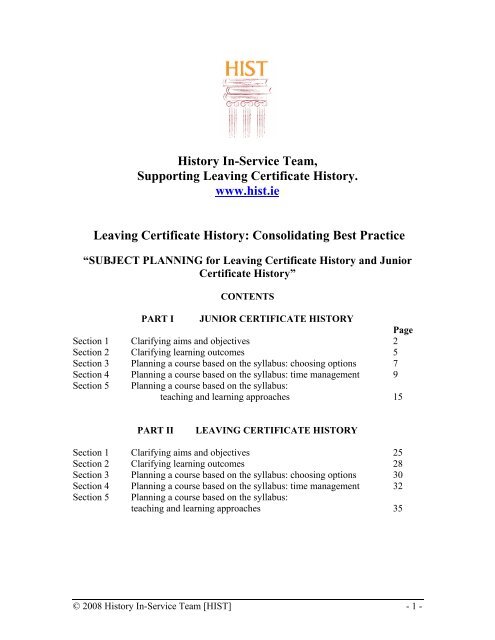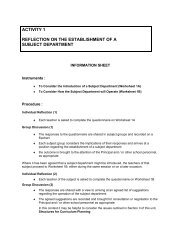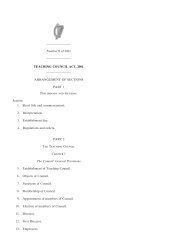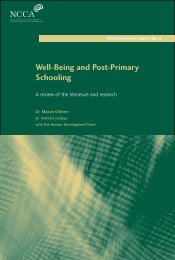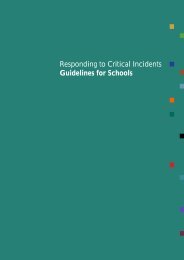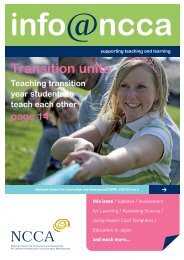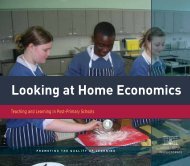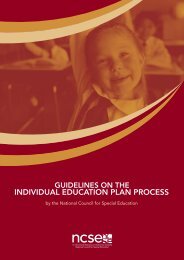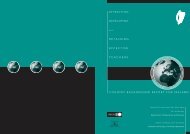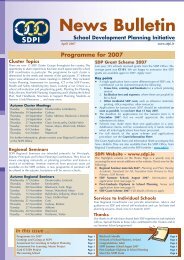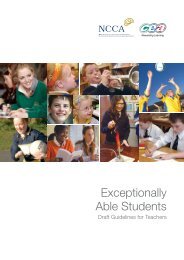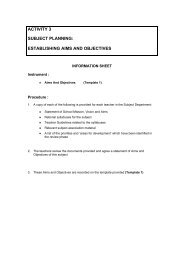History Subject Planning Guidelines - Scoilnet
History Subject Planning Guidelines - Scoilnet
History Subject Planning Guidelines - Scoilnet
- No tags were found...
You also want an ePaper? Increase the reach of your titles
YUMPU automatically turns print PDFs into web optimized ePapers that Google loves.
<strong>History</strong> In-Service Team,Supporting Leaving Certificate <strong>History</strong>.www.hist.ieLeaving Certificate <strong>History</strong>: Consolidating Best Practice“SUBJECT PLANNING for Leaving Certificate <strong>History</strong> and JuniorCertificate <strong>History</strong>”CONTENTSPART I JUNIOR CERTIFICATE HISTORYPageSection 1 Clarifying aims and objectives 2Section 2 Clarifying learning outcomes 5Section 3 <strong>Planning</strong> a course based on the syllabus: choosing options 7Section 4 <strong>Planning</strong> a course based on the syllabus: time management 9Section 5 <strong>Planning</strong> a course based on the syllabus:teaching and learning approaches 15PART IILEAVING CERTIFICATE HISTORYSection 1 Clarifying aims and objectives 25Section 2 Clarifying learning outcomes 28Section 3 <strong>Planning</strong> a course based on the syllabus: choosing options 30Section 4 <strong>Planning</strong> a course based on the syllabus: time management 32Section 5 <strong>Planning</strong> a course based on the syllabus:teaching and learning approaches 35© 2008 <strong>History</strong> In-Service Team [HIST] - 1 -
PART IJUNIOR CERTIFICATE HISTORYSection 1Clarifying aims and objectivesWhy?While much discussion of history syllabi focuses on what is described as ‘content’ (i.e.the specific modules and topics that are to be studied by students), inadequate attentionpaid to aims and objectives may result in the purposes that inspired the selection ofcontent being overlooked or ignored. As in all aspects of School Development <strong>Planning</strong>,subject planning requires that targets be identified and worked towards; and, as in allsubjects, the targets that the teacher is meant to pursue with her/his students are set downin the syllabus aims and objectives.Managing to reach targets is contingent on many factors. One important factor is vision.If we cannot see clearly the nature of the target at which we are aiming, then our capacityto reach the target is likely to be impeded. Both the Junior and Leaving Certificate<strong>History</strong> syllabi have introductions which discuss the nature of history and of the syllabus.In tandem with the aims and objectives, these provide a coherent framework foridentifying targets and understanding the rationale that inspired them.What are ‘aims’ and ‘objectives’?Aims are probably best described as broad statements of the learning that the syllabus isdesigned to bring about in students.Objectives involve a more detailed identification and itemisation of the learning that thesyllabus is designed to bring about in students.If aims and objectives are to achieve the status of realisable targets, it is important thatthey be linked to teaching and learning in the classroom. Thus, in the pages that follow,teachers – both individually and collectively – are encouraged to reflect on how specificaims and objectives are linked to specific modules or topics being taught at differentstages of the students’ engagement with the syllabus.Important documentationJunior Certificate <strong>History</strong> syllabusJunior Certificate <strong>History</strong> <strong>Guidelines</strong> for Teachers (revised, 1996)Available at www.education.ie. Look under “Curriculum, syllabus and teaching guides”.Also available at www.ncca.ie. Look in drop-down menu in “curriculum online” section.© 2008 <strong>History</strong> In-Service Team [HIST] - 2 -
Junior Certificate <strong>History</strong>: AimsTo what extent and in what aspects of our work are we helping our students toachieve the following aims?Junior Certificate <strong>History</strong>Template 1AAimThis syllabus aims to ensure that students:Aspects of our work to which this aim isrelevant2.1.1 Acquire knowledge of andunderstanding about human activity in thepast2.1.2 Understand the contemporary worldthrough the study of the past2.1.3 Develop conceptual understandingand the ability to think independently2.1.4 Develop a range of skills essential forthe study of history2.1.5 Are encouraged to develop positiveattitudes such as a commitment toobjectivity and fairness, and an acceptancethat people and events must be judged inthe context of their values and time2.1.6 Are encouraged to develop an interestand enthusiasm for history and a value oftheir heritage from the past© 2008 <strong>History</strong> In-Service Team [HIST] - 3 -
Junior Certificate <strong>History</strong>: ObjectivesSome syllabus objectives apply throughout the students’ course of study based on thesyllabus; other objectives are relevant to particular sections of the syllabus. Discusswhere you would place the listed objectives (Junior Certificate syllabus, pp. 3-6: SeeAppendix 1, p. 41) and your reasons for so doing.Junior Certificate <strong>History</strong>: Template 1BCategoryObjectivesObjectives that apply to the entire course ofstudyObjectives that are relevant to particular sections of the syllabusObjectives of particular relevance toSection IObjectives of particular relevance toSection IIObjectives of particular relevance toSection III© 2008 <strong>History</strong> In-Service Team [HIST] - 4 -
Section 2Clarifying learning outcomesWhy?Learning outcomes derive from the aims and objectives of a syllabus and haveimplications for the manner in which different parts of the syllabus should be taught.Since one of the keys to effective teaching is the use of a range of methodologies,learning outcomes are useful in guiding teachers as to the type of methodologies that areappropriate to the teaching of different parts of the syllabus.Learning outcomes also have implications for the manner in which the different syllabustopics are to be examined. The aims and objectives set out the targets that the teacherendeavours to reach with her/his pupils: the learning outcomes set out what the student isexpected to know and/or be able to do at the end of the course of learning and, therefore,the basis on which the student will be assessed through the written examination and/orother assessment instruments.The Junior Certificate syllabus as implemented in schools from September 1989 had nostated learning outcomes. A set of learning outcomes for each section of the syllabus willbe included in the re-balanced syllabus which is due to be implemented from September2009 or 2010. Since many of the learning outcomes in the re-balanced syllabus arerelevant to the syllabus as it currently stands, teachers may wish to consult the learningoutcomes which are available online athttp://www.ncca.ie/uploadedfiles/Junior%20Cycle%20Review/<strong>History</strong>_syll(2).pdfWhat are ‘learning outcomes’?Learning outcomes are statements describing what students are expected to know,understand and/or be able to do at the end of a particular course of study. As well asguiding the teaching and learning that takes place in the classroom, they also serve toidentify the bases on which the external, summative assessment of the student’s learningwill take place.© 2008 <strong>History</strong> In-Service Team [HIST] - 5 -
Junior Certificate <strong>History</strong> syllabus: Template 2Remember:• Learning outcomes derive from the aims and objectives of a syllabus and haveimplications for the manner in which different parts of the syllabus should be taught.• Learning outcomes have implications for the manner in which the two sections of thesyllabus are to be examined and need to be borne in mind when planning revision.Important questions to ask in respects of the learning outcomesSection What are the implications of the learning outcomes for the ways in which weteach this section and for our examination preparation strategies?SectionISectionIISectionIII© 2008 <strong>History</strong> In-Service Team [HIST] - 6 -
Section 3<strong>Planning</strong> a course based on the Junior Certificate <strong>History</strong> syllabus:choosing optionsThe Junior Certificate <strong>History</strong> syllabus contains a range of options; therefore, teachersand history departments need to work out which particular options will be chosen so thatthe course of study to be followed with the students may be determined. In addition,some topics on the syllabus allow a focus on local examples and there is a need toconsider if and where this may be appropriate. In most schools, a departmental plan willbe agreed, so that students in different classes are pursuing the same sections of thesyllabus at the same time, with due consideration given to those with special educationalneeds and the targeted interventions that may be required. Departmental planning shouldnot be such as to stifle the creativity and methodological approaches of individualteachers.The templates that follow are intended to focus attention on the options and flexibleapproaches to which individual teachers and departments will need to give attention.Junior Certificate <strong>History</strong> syllabus, Section I: Template 3ATopic Issue for consideration Our decisionOur roots in ancientcivilisationWhich ancient civilisation(outside of Ireland):Egypt, Greece, Rome, otherCastle, church and cityAny local examples we shoulduse?Medieval town/cityMedieval manorMedieval castleMedieval monasteryRenaissanceWhich countries/regions tofocus on?Which artists, architects,printer(s) to focus on?© 2008 <strong>History</strong> In-Service Team [HIST] - 7 -
Junior Certificate <strong>History</strong> syllabus, Section II: Template 3BTopicIssue for consideration:special studyOur decisionChanges in European view ofthe world:ExplorationWhich (voyage of)exploration?e.g. Columbus, 1492;Magellan, 1519-1522Religious change:ReformationWhich reformer?e.g. Luther, Calvin, Henry VIIIChanges in land ownership:Plantation in IrelandWhich plantation?e.g. Munster, Laois-Offaly,UlsterPolitical change:Revolutionary movementsWhich revolutionary?e.g. Washington, Robespierre,Wolfe ToneIssues to consider in making choices:• Resources available – including ‘appropriate documentary sources’, as referred toin the syllabus• Most engaging narratives for students• Choices offering best opportunities to develop students’ understanding of conceptof change, and understanding of cause and consequence• Choices offering best opportunities to develop students’ understanding of conceptof evidence© 2008 <strong>History</strong> In-Service Team [HIST] - 8 -
Junior Certificate <strong>History</strong> syllabus, Section III: Template 3CFor students who will sit the Ordinary level examination:• Which two topics should we select?Political developments in Ireland and International relations in the 20 th centuryORSocial change in the 20 th century and International relations in the 20 th century• In relation to the topic “International relations in the 20 th century”, which optionshould we select?Peace and war in Europe, 1920-1945ORThe rise of the SuperpowersORMoves towards European unityORAfrican and Asian nationalism________________________________________________________________________N.B.Students who will sit the Higher level examination study all three topics:Political developments in Ireland andInternational relations in the 20 th century andSocial change in the 20 th century.In the topic ‘International relations in the 20 th century’, for the post-1945 period theystudy ONE of the three options below.Topic Issue for consideration Our decisionInternationalrelations inthe 20 thcentury1945-1980s: Which option?The rise of the SuperpowersMoves towards European unityAfrican and Asian nationalismORORIssues to consider in making choices:• Resources available• Choices offering best opportunities to develop students’ understanding of modernworld• Choice offering best opportunities to develop students’ disciplinary understanding(i.e. understanding of the nature of history)© 2008 <strong>History</strong> In-Service Team [HIST] - 9 -
Section 4<strong>Planning</strong> a course based on the Junior Certificate <strong>History</strong> syllabi:time managementA perennial complaint about history courses worldwide is that they are ‘too long’.Whatever one’s view on this issue, it is undoubtedly the case that careful planning andtime management can help to ensure that courses taught fulfil curricular requirements andare educationally meaningful. Incorporating syllabus emphases into one’s teaching canhelp to ensure that time is being used effectively to develop students’ on-goingunderstanding and competencies.The following templates are intended to assist history teachers and departments inorganising their teaching of syllabus topics within viable time parameters.Junior Certificate <strong>History</strong> syllabus: Template 4ASection I: How we find out about the pastTopicIntroduction:• The job of the historianTo becompleted by…Numberof classesavailableSyllabus emphasesHistorical methods,different types of sourcesOur roots in ancientcivilisation:• Pre-Christian & earlyChristian Ireland• Ancient Egypt, Greece,Rome or other ancientcivilisationStudy based onarchaeological evidenceof• Houses, food, familylife• Work, art, crafts, tools• Burial customsCastle, church and city:• Medieval society• Medieval city• Medieval manor• Medieval castle• Medieval monastery andparishStudy based on buildings,settlements, other materialsourcesLocal examples and/ornational examples and/orEuropean examplesRenaissance:• Renaissance art• Renaissance architecture• Renaissance printing andlearningStudy based on visualsources and biography© 2008 <strong>History</strong> In-Service Team [HIST] - 10 -
Junior Certificate <strong>History</strong> syllabus: Template 4BSection II: Studies of changeTopicTo becompletedby …Numberof classesavailableSyllabus emphasesChanges in European view of theworld: ExplorationExploring changethrough• Why people wanted new searoutes• What made the voyagespossible• The main consequences of thesevoyagesSpecial study: An account of ONEexploration• Understanding ofcause &consequence• Use of appropriatedocumentarysources• The special studyReligious change: Reformation• Why the Reformation occurred• How different people wentabout reform• The main consequences of theReformationSpecial study: Life of ONEreformer & the effect he hadExploring changethrough• Understanding ofcause &consequence• Use of appropriatedocumentarysources• The special studyChanges in land ownership:Plantation in IrelandExploring changethrough• Why the land changed hands• How the land changed hands• Main consequences of thechangeSpecial study: ONE plantation inIreland• Understanding ofcause &consequence• Use of appropriatedocumentarysources• The special study© 2008 <strong>History</strong> In-Service Team [HIST] - 11 -
Junior Certificate <strong>History</strong> syllabus: Template 4B (continued)TopicTo becompletedbyNumberof classesavailableSyllabus emphasesPolitical change: RevolutionarymovementsExploring changethrough• Background: sources ofdiscontent in pre-revolutionaryAmerica, France & Ireland• Revolutionary movements inAmerica, France & Ireland, late18 th century• Consequences of theserevolutions• Understanding ofcause &consequence• Use of appropriatedocumentarysources• The special studySpecial study: Life of ONErevolutionary in America, France orIrelandSocial change: From farm tofactoryExploring changethrough• Background: agriculturalsociety in the 18 th century• Factors which made theagricultural & industrialrevolutions possible• Effects of changes in industry &agriculture on people’s lives• Understanding ofcause &consequence• Use of appropriatedocumentarysources• The special studySpecial study: Contrasting lifestyles c.1850: Industrial England &rural Ireland© 2008 <strong>History</strong> In-Service Team [HIST] - 12 -
Junior Certificate <strong>History</strong> syllabus: Template 4CSection III: Understanding the modern worldNote: In Section III, decisions need to be taken on a number of options. For details, seepage 9 of this booklet. Topic details are based on the Revised <strong>Guidelines</strong> of 1996.TopicTo becompletedby …Numberof classesavailableSyllabusemphasesPolitical developments in Ireland in the20 th centuryThe main political events in Ireland, 1900to 1985• Aims & methods of the main Irishpolitical groups (nationalist &unionist) & individuals at the turn ofthe 20 th centuryAn overalloutline & not aseries of detailedstudiesPossible focus on• Focus dates• Personalities• Concepts• Events & movements of the period1912-1922 leading to the foundationof the two political entities, north &south• The main developments in, andcontrasts between, the two politicalentities from 1922 to 1985Use ofappropriateresources e.g.film, TV/radioprogrammes,newspapersSocial change in the 20 th centuryChanges in lifestyles in Ireland fromc.1900 under each of the followingheadings:Study of changesin local area ormore generalstudy• The role of women• Work & leisure• Urban & rural life• Transport & communicationsUse of oralhistory, familyhistory,photographs© 2008 <strong>History</strong> In-Service Team [HIST] - 13 -
Junior Certificate <strong>History</strong> syllabus: Template 4C (continued)International relations in the 20 th centuryHigher level: A + (B or C or D). Ordinary level: A or B or C or D.TopicTo becompletedby …Numberof classesavailableSyllabusemphasesA. 1920-1945 Peace & war in Europe• The rise of Fascism in Italy &Germany, 1920-33• The drift to war in Europe, 1933-39• World War II in Europe, 1939-45A study ininternationalrelations; notnecessary to makein-depth studies ofinternal history ofcountries involvedB. Post-1945: The rise of theSuperpowers• The Berlin Blockade• The Korean War• The Cuban CrisisStudies of thesources of conflict& how to resolve itBackground,ideologicaldifferences, effectsof conflicts, effortsto resolve conflictsC. Post-1945: Moves towardsEuropean unity• The Treaty of Rome• The growth of the European Union• The Maastricht TreatyD. Post-1945: African & AsiannationalismEconomic &politicalbackground todesire for unity &extent to whichaims have beenachievedChoose ONE country in Africa or Asiathat emerged from a colonial past tobecome independent after 1945• The colonial background• The independence movement• The post-colonial experienceSee bullet pointsunder D in firstcolumn© 2008 <strong>History</strong> In-Service Team [HIST] - 14 -
Section 5<strong>Planning</strong> a course based on the Junior Certificate <strong>History</strong> syllabus:teaching and learning approachesThe Junior Certificate <strong>History</strong> <strong>Guidelines</strong> for Teachers (Revised, 1996) includesuggested teaching and learning approaches, and these approaches, along withappropriate page references, are referred to in the templates that follow.The guidelines are available atwww.education.iewww.ncca.ieLook under “Curriculum, syllabus and teaching guides”.Look in drop-down menu in “curriculum online” section.Another useful source to guide planning is the report Looking at <strong>History</strong> (2006), apublication of the DES Inspectorate and based on 50 school inspections in <strong>History</strong>.Chapter 3, ‘Teaching and learning’ (pp. 23-34) focuses on teaching and learningapproaches observed and their impact. Some approaches noted in the report are includedin the templates that follow.Looking at <strong>History</strong> is available at www.education.ieLook under “Reports and publications” → “Post-primary”.It is generally acknowledged that there is no one, ‘catch-all’ approach that works betterthan all others in the classroom; but that a variety of approaches is needed toaccommodate different learning styles among students and to engage appropriately withdifferent facets of the syllabus. In the template documents that follow, teachers,individually and in subject teams, are invited to consider the appropriateness of theapproaches listed to the different sections of the Junior Certificate <strong>History</strong> syllabus; toidentify other approaches that they have found useful and productive; and to identify theresources that are available to support the preferred approaches.© 2008 <strong>History</strong> In-Service Team [HIST] - 15 -
Junior Certificate <strong>History</strong> syllabus: Template 5ASection I: How we find out about the pastTopic Syllabus emphases Appropriate approaches?Introduction:• The job of thehistorianHistorical methods,different types of sources<strong>Guidelines</strong>, pp. 4-6• Time capsule exercise• Building a story fromclues• Classifying evidence• Examining evidence• Family history• Other?Our roots in ancientcivilisation:• Pre-Christian & earlyChristian Ireland• Ancient Egypt,Greece, Rome or otherancient civilisationStudy based onarchaeological evidence of• Houses, food, familylife• Work, art, crafts, tools• Burial customs<strong>Guidelines</strong>, pp. 6-7• Use of pictures, drawings,models• Use of film as basis fordiscussion of sites,artefacts, monuments• Ireland: exploring localexamples, museums• Other?Castle, church and city:• Medieval society• Medieval city• Medieval manor• Medieval castle• Medieval monastery,parishRenaissance:• Renaissance art• Renaissancearchitecture• Renaissance printingand learningStudy based on buildings,settlements, other materialsourcesLocal examples and/ornational examples and/orEuropean examplesStudy based on visualsources and biography<strong>Guidelines</strong>, pp. 7-8• Visits, field trips, usingwork sheets, trail booklets• Use of maps, outlineplans• Other?<strong>Guidelines</strong>, pp. 8-9• Use of visual sources: useas sources not illustration• Collaboration with artteacher(s)• Biographical studies• Other?© 2008 <strong>History</strong> In-Service Team [HIST] - 16 -
Junior Certificate <strong>History</strong> syllabus: Template 5ASection I: How we find out about the pastPreferred approaches and available resources to support these approachesIntroduction: The job of the historian………………………………………………………………………………………………………………………………………………………………………………………………………………………………………………………………………………………………Our roots in ancient civilisation:• Pre-Christian & early Christian Ireland………………………………………………………………………………………………………………………………………………………………………………………………………………………………………………………………………………………………• Ancient Egypt, Greece, Rome or other ancient civilisation………………………………………………………………………………………………………………………………………………………………………………………………………………………………………………………………………………………………Castle, church and city:medieval society; medieval city; medieval manor; medieval castle; medieval monastery.................................................................................................................................................................................................................................................................................................................................................................................................................................................Renaissance: Renaissance art, Renaissance architecture, Renaissance printing & learning………………………………………………………………………………………………………………………………………………………………………………………………………………………………………………………………………………………………© 2008 <strong>History</strong> In-Service Team [HIST] - 17 -
Junior Certificate <strong>History</strong> syllabus: Template 5BSection II: Studies of changeTopic Syllabus emphases Appropriateapproaches?Changes in European view of theworld: Exploration• Why people wanted new searoutes• What made the voyagespossible• The main consequences of thesevoyagesSpecial study: An account of ONEexplorationExploring changethrough• Understanding ofcause &consequence• Use of appropriatedocumentarysources• The special study<strong>Guidelines</strong>, pp.11-12• Use of maps andglobes: mapsshowingcontemporaryknowledge ofworld, routes ofvoyages• Detailed practicalstudy of anexploration• Other?Religious change: Reformation• Why the Reformation occurred• How different people wentabout reform• The main consequences of theReformationSpecial study: Life of ONEreformer & the effect he hadExploring changethrough• Understanding ofcause &consequence• Use of appropriatedocumentarysources• The special study<strong>Guidelines</strong>, p.12• Use of practicalexamples to explainsome abstract andtechnical terms• Use of role play anddebates• Other?Changes in land ownership:Plantation in Ireland• Why the land changed hands• How the land changed hands• Main consequences of thechangeSpecial study: ONE plantation inIrelandExploring changethrough• Understanding ofcause &consequence• Use of appropriatedocumentarysources• The special study<strong>Guidelines</strong>, p.13• Use ofcontemporaryaccounts &illustrations• Use of statistics• Use of mapsshowing impact• Other?© 2008 <strong>History</strong> In-Service Team [HIST] - 18 -
Junior Certificate <strong>History</strong> syllabus: Template 5B (continued)Topic Syllabus emphases Appropriateapproaches?Political change: Revolutionarymovements• Background: sources ofdiscontent in pre-revolutionaryAmerica, France & Ireland• Revolutionary movements inAmerica, France & Ireland, late18 th century• Consequences of theserevolutionsSpecial study: Life of ONErevolutionary in America, France orIrelandExploring changethrough• Understanding ofcause &consequence• Use of appropriatedocumentarysources• The special study<strong>Guidelines</strong>, pp. 14-15• Use ofcontemporarycartoons & portraits• Other?Social change: From farm tofactory• Background: agriculturalsociety in the 18 th century• Factors which made theagricultural & industrialrevolutions possible• Effects of changes in industry &agriculture on people’s livesSpecial study: Contrasting lifestyles c.1850: Industrial England &rural IrelandExploring changethrough• Understanding ofcause &consequence• Use of appropriatedocumentarysources• The special study<strong>Guidelines</strong>, p.15• Use ofcontemporaryillustration• Use of documentarymaterial e.g.accounts of travels,governmentcommissions &other enquiries• Collaboration withother subject arease.g. Science, Art• Other?© 2008 <strong>History</strong> In-Service Team [HIST] - 19 -
Junior Certificate <strong>History</strong> syllabus: Template 5B (continued)Section II: Studies of changePreferred approaches and available resources to support these approachesChanges in European view of the world: Exploration………………………………………………………………………………………………………………………………………………………………………………………………………………………………………………………………………………………………Religious change: Reformation………………………………………………………………………………………………………………………………………………………………………………………………………………………………………………………………………………………………Changes in land ownership: Plantation in Ireland………………………………………………………………………………………………………………………………………………………………………………………………………………………………………………………………………………………………Political change: Revolutionary movements................................................................................................................................................................................................................................................................................................................................................................................................................................................Social change: From farm to factory………………………………………………………………………………………………………………………………………………………………………………………………………………………………………………………………………………………………© 2008 <strong>History</strong> In-Service Team [HIST] - 20 -
Junior Certificate <strong>History</strong> syllabus: Template 5CSection III: Understanding the modern worldTopicSyllabusemphasesAppropriate approaches?Political developments in Ireland in[the late 19 th century and] the 20 thcenturyThe main political events in Ireland,1900 to 1985• Aims & methods of the main Irishpolitical groups (nationalist &unionist) & individuals at the turnof the 20 th century• Events & movements of the period1912-1922 leading to thefoundation of the two politicalentities, north & south• The main developments in, andcontrasts between, the two politicalentities from 1922 to 1985An overall outline& not a series ofdetailed studies<strong>Guidelines</strong>, p.17• Use of photographs,posters, newspapers,radio & TV broadcasts,films• Focus dates, using timechart or time line• Focus on key politicalpersonalities & theirideas• Focus on key politicalconcepts• Other?Social change in the 20 th centuryChanges in lifestyles in Ireland fromc.1900 under each of the followingheadings:• The role of women• Work & leisure• Urban & rural life• Transport & communicationsStudy of changesin local area ormore general study<strong>Guidelines</strong>, p.18• Oral history project• Study of students’ ownfamily history duringthe period• Use of photographs• Thematic approach e.g.focus on technologicalchange or modernisation• Other?© 2008 <strong>History</strong> In-Service Team [HIST] - 21 -
Junior Certificate <strong>History</strong> syllabus: Template 5C (continued)Topic Syllabus emphases Appropriate approaches?International relations in the 20 thcenturyA. 1920-1945 Peace & war in Europe• The rise of Fascism in Italy &Germany, 1920-33• The drift to war in Europe, 1933-39• World War II in Europe, 1939-45B. Post-1945: The rise of theSuperpowers• The Berlin Blockade• The Korean War• The Cuban CrisisC. Post-1945: Moves towardsEuropean unity• The Treaty of Rome• The growth of the European Union• The Maastricht TreatyD. Post-1945: African & AsiannationalismChoose ONE country in Africa or Asiathat emerged from a colonial past tobecome independent after 1945• The colonial background• The independence movement• The post-colonial experienceA study ininternationalrelations; notnecessary to makein-depth studies ofinternal history ofcountries involvedStudies of thesources of conflictand how to resolveconflictBackground,ideologicaldifferences, effectsof conflicts, effortsto resolve conflictsEconomic &politicalbackground todesire for unity &extent to whichaims have beenachievedSee bullet points infirst column• Use of oral questioning• Use of spider diagrams• Use as prompts atbeginning of lessons ofphotographs, maps,cartoons, short audio orvideo clips• Use of provocativequestions at beginningof lessons to engagestudents• Development bystudents of a ‘historydictionary’• Use of time lines onclassroom walls• Class analysis of visualsources• Use of class debates asa revision aid• Assisting students to‘make’ notes ratherthan ‘take’ notes• Selective and focuseduse of textbook(s)• Use of pair work andgroup work• Focus on the role ofkey political figures• Focus on key politicalconcepts• Use of role playing• Use of charts, wallmountedor boardmounted• Use of video clips forreinforcement purposes© 2008 <strong>History</strong> In-Service Team [HIST] - 22 -
Junior Certificate <strong>History</strong> syllabus: Template 5CSection III: Understanding the modern worldPreferred approaches and available resources to support these approachesPolitical developments in Ireland in the 20 th century• Aims & methods of the main Irish political groups (nationalist & unionist) &individuals at the turn of the 20 th century………………………………………………………………………………………………………………………………………………………………………………………………………………………………………………………………………………………………• Events & movements of the period 1912-1922 leading to the foundation of the twopolitical entities, north & south………………………………………………………………………………………………………………………………………………………………………………………………………………………………………………………………………………………………• The main developments in, and contrasts between, the two political entities from1922 to 1985………………………………………………………………………………………………………………………………………………………………………………………………………………………………………………………………………………………………Changes in lifestyles in Ireland from c.1900 under each of the following headings:The role of women; Work & leisure; Urban & rural life; Transport & communications………………………………………………………………………………………………………………………………………………………………………………………………………………………………………………………………………………………………© 2008 <strong>History</strong> In-Service Team [HIST] - 23 -
Junior Certificate <strong>History</strong> syllabus: Template 5CSection III: Understanding the modern worldPreferred approaches and available resources to support these approaches(continued)International relations in the 20 th centuryA. 1920-1945: Peace & war in Europe• The rise of Fascism in Italy & Germany, 1920-33………………………………………………………………………………………………………………………………………………………………………………………………………………………………………………………………………………………………• The drift to war in Europe, 1933-39………………………………………………………………………………………………………………………………………………………………………………………………………………………………………………………………………………………………• World War II in Europe, 1939-45................................................................................................................................................................................................................................................................................................................................................................................................................................................B. Post-1945: The rise of the Superpowers OR Moves towards European unity ORAfrican and Asian nationalism………………………………………………………………………………………………………………………………………………………………………………………………………………………………………………………………………………………………© 2008 <strong>History</strong> In-Service Team [HIST] - 24 -
PART IILEAVING CERTIFICATE HISTORYSection 1Clarifying aims and objectivesWhy?While much discussion of history syllabi focuses on what is described as ‘content’ (i.e.the specific modules and topics that are to be studied by students), inadequate attentionpaid to aims and objectives may result in the purposes that inspired the selection ofcontent being overlooked or ignored. As in all aspects of School Development <strong>Planning</strong>,subject planning requires that targets be identified and worked towards; and, as in allsubjects, the targets that the teacher is meant to pursue with her/his students are set downin the syllabus aims and objectives.Managing to reach targets is contingent on many factors. One important factor is vision.If we cannot see clearly the nature of the target at which we are aiming, then our capacityto reach the target is likely to be impeded. Both the Junior and Leaving Certificate<strong>History</strong> syllabi have introductions which discuss the nature of history and of the syllabus.In tandem with the aims and objectives, these provide a coherent framework foridentifying targets and understanding the rationale that inspired them.What are ‘aims’ and ‘objectives’?Aims are probably best described as broad statements of the learning that the syllabus isdesigned to bring about in students.Objectives involve a more detailed identification and itemisation of the learning that thesyllabus is designed to bring about in students.If aims and objectives are to achieve the status of realisable targets, it is important thatthey be linked to teaching and learning in the classroom. Thus, in the pages that follow,teachers – both individually and collectively – are encouraged to reflect on how specificaims and objectives are linked to specific modules or topics being taught at differentstages of the students’ engagement with the syllabus.Important documentationJunior Certificate <strong>History</strong> syllabus: Leaving Certificate <strong>History</strong> syllabus; LeavingCertificate <strong>History</strong>, <strong>Guidelines</strong> for Teachers (2004)Available at www.hist.ie.Also available at www.education.ie. Look under “Curriculum, syllabus and teachingguides”.Also available at www.ncca.ie. Look in drop-down menu in “curriculum online” section.© 2008 <strong>History</strong> In-Service Team [HIST] - 25 -
Leaving Certificate <strong>History</strong> syllabus: aimsTo what extent and in what aspects of our work are we helping our students toachieve the following aims?Template 1A: AimsAimKnowledge and understandingTo develop knowledge and understanding of humanactivity in the pastTo promote understanding of the present through thedevelopment of a historical perspective on issues ofcontemporary importanceTo develop knowledge and understanding of Irish,European and world history.To develop students’ understanding of historicalconceptsTo provide students with a perspective of change in aworld of changeSkills of historyTo develop an awareness of different interpretations ofparticular historical issues.To develop a range of research skills essential for thestudy of historyTo develop an appreciation of the nature and variety ofhistorical evidence.Preparation for life & citizenshipTo develop the ability to think criticallyAspects of our work to whichthis aim is relevantTo develop positive values associated with the study ofhistoryTo develop in students an appreciation of the society inwhich they live and of other societies, past and presentTo develop in students an informed and criticalawareness of their historical inheritance© 2008 <strong>History</strong> In-Service Team [HIST] - 26 -
Leaving Certificate <strong>History</strong> syllabus: objectivesSome syllabus objectives apply throughout the students’ course of study based on thesyllabus; other objectives are relevant to particular sections of the syllabus. Discusswhere you would place the listed objectives (Leaving Certificate syllabus, pp. 3-4; seeAppendix 2, p. 44) and your reasons for so doing.Template 1B: Leaving Certificate <strong>History</strong> syllabus: objectivesCategoryObjectivesObjectives thatapply to theentire course ofstudyObjectives that are relevant to particular sections of the syllabusObjectives ofparticularrelevance to thedocuments-basedstudyObjectives ofparticularrelevance to theresearch studyObjectives ofparticularrelevance to thethree ‘standard’topics© 2008 <strong>History</strong> In-Service Team [HIST] - 27 -
Section 2Clarifying learning outcomesWhy?The learning outcomes derive from the aims and objectives of the syllabus and haveimplications for the manner in which different parts of the syllabus should be taught.Since one of the keys to effective teaching is the use of a range of methodologies,learning outcomes are useful in guiding teachers as to the type of methodologies that areappropriate to the teaching of different parts of the syllabus.The learning outcomes also have implications for the manner in which the differentsyllabus topics are to be examined. The aims and objectives set out the targets that theteacher endeavours to reach with her/his pupils: the learning outcomes set out what thestudent is expected to know and/or be able to do at the end of the course of learning and,therefore, the basis on which the student will be assessed through the written examinationand/or other assessment instruments.The Leaving Certificate syllabus has learning outcomes for the two inter-linked parts ofthe syllabus, Working with evidence, and Topics for study: these may be found on pages10 and 13 of the syllabus, respectively.What are ‘learning outcomes’?Learning outcomes are statements describing what students are expected to know,understand and/or be able to do at the end of a particular course of study. As well asguiding the teaching and learning that takes place in the classroom, they also serve toidentify the bases on which the external, summative assessment of the student’s learningwill take place.© 2008 <strong>History</strong> In-Service Team [HIST] - 28 -
Template 2: Leaving Certificate <strong>History</strong> syllabus: learning outcomesRemember:• Learning outcomes derive from the aims and objectives of a syllabus and haveimplications for the manner in which different parts of the syllabus should be taught.• Learning outcomes have implications for the manner in which the two sections of thesyllabus are to be examined and need to be borne in mind when planning revision.Important questions to ask in respects of the learning outcomesSectionWhat are the implications of these learning outcomes forthe ways in which we teach this part of the syllabus andfor our examination preparation strategies?Part IWorking with evidencePart IITopics for study© 2008 <strong>History</strong> In-Service Team [HIST] - 29 -
Section 3<strong>Planning</strong> a course based on the Leaving Certificate <strong>History</strong> syllabus:choosing optionsThe Leaving Certificate <strong>History</strong> syllabus contains a range of options; therefore, teachersand history departments need to work out which particular options will be chosen so thatthe course of study to be followed with the students may be determined. In most schools,a departmental plan will be agreed, so that students in different classes are pursuing thesame sections of the syllabus at the same time, with due consideration given to those withspecial educational needs and the targeted interventions that may be required.Departmental planning should not be such as to stifle the creativity and methodologicalapproaches of individual teachers.The template that follows is intended to guide teachers in the choice of options.Issues to consider in making choices:• Resources available• Choices offering best opportunities to develop students’ understanding of modernworld• Choice offering best opportunities to develop students’ disciplinary understanding(i.e. understanding of the nature of history)© 2008 <strong>History</strong> In-Service Team [HIST] - 30 -
Template 3: Leaving Certificate <strong>History</strong> syllabus: Topics for studyThe first choice to be made here is whether topics will be taken from the Early Modernfield of study, 1492-1815, OR the Later Modern field of study, 1815-1993. Once thatchoice has been made, there will be a need to check which topic has been prescribed fordocuments-based study.Teachers must then choose three further topics from the same field of study.Early Modern topicsNote: Two topics from Irish history are studied and two from the history ofEurope and the wider world.The four topics ourstudents will studyWhich of the topics below is prescribed for documents-based study for thiscohort of students?Irish history1. Reform and Reformation in Tudor Ireland, 1494-15582. Rebellion and conquest in Elizabethan Ireland, 1558-16033. Kingdom versus colony – the struggle for mastery in Ireland, 1603-16604. Establishing a colonial ascendancy, 1660-17155. Colony versus kingdom – tensions in mid-18 th century Ireland, 1715-17706. The end of the Irish kingdom and the establishment of the Union, 1770-1815<strong>History</strong> of Europe and the wider world1. Europe from Renaissance to Reformation, 1492-15672. Religion and power – politics in the later sixteenth century, 1567-16093. The eclipse of Old Europe, 1609-16604. Europe in the age of Louis XIV, 1660-17155. Establishing empires, 1715-17756. Empires in revolution, 1775-1815Later Modern topicsNote: Two topics from Irish history are studied and two from the history ofEurope and the wider world.The four topics ourstudents will studyWhich of the topics below is prescribed for documents-based study for thiscohort of students?Irish history1. Ireland and the Union, 1815-18702. Movements for political and social reform, 1879-19143. The pursuit of sovereignty and the impact of partition, 1912-19494. The Irish diaspora, 1840-19665. Politics and society in Northern Ireland, 1949-19936. Government, economy and society in the Republic of Ireland, 1949-1989<strong>History</strong> of Europe and the wider world1. Nationalism and state formation in Europe, 1815-18712. Nation states and international tensions, 1871-19203. Dictatorship and democracy, 1920-19454. Division and realignment in Europe, 1945-19925. European retreat from empire and the aftermath, 1945-19906. The United States and the world, 1945-1989© 2008 <strong>History</strong> In-Service Team [HIST] - 31 -
Section 4<strong>Planning</strong> a course based on the Leaving Certificate <strong>History</strong> syllabus::time managementA perennial complaint about history courses worldwide is that they are ‘too long’.Whatever one’s view on this issue, it is undoubtedly the case that careful planning andtime management can help to ensure that courses taught fulfil curricular requirements andare educationally meaningful. Incorporating syllabus emphases into one’s teaching canhelp to ensure that time is being used effectively to develop students’ on-goingunderstanding and competencies.The following templates are intended to assist history teachers and departments inorganising their teaching of syllabus topics within viable time parameters.© 2008 <strong>History</strong> In-Service Team [HIST] - 32 -
Template 4A: A possible schedule for Fifth Year <strong>History</strong>(See <strong>Guidelines</strong> for Teachers, p.20)Teaching focusNumberof classesallocatedTo becompletedby …Syllabus emphasesIntroduction: history &the historian• Different meanings attached to‘history’• provisional nature of historicalknowledge• concepts of evidence,interpretation, objectivity,change• what historical researchinvolvesTopic prescribed fordocuments-basedstudyNote: See student guide toDocuments-based Study onwww.hist.ie.See ‘learning outcomes’ on page 10of syllabusFocus on• Case studies (and context)• Role of evidence• Types of sources• Provenance of sources2 nd topic (of four) See ‘learning outcomes’ on page 13of syllabusFocus on• Important changes• Case studies• Role of key personalities• Key concepts (HL)Research study: initialbriefing on parametersand research methods(and, where deemeddesirable, outline plan& initial draft)Note: See student guide toResearch Study on www.hist.ie.See ‘learning outcomes’ on page 10of syllabusFocus on• Awareness of objectivity• Exemplifying research skills© 2008 <strong>History</strong> In-Service Team [HIST] - 33 -
Template 4B: A possible schedule for Sixth Year <strong>History</strong>(See <strong>Guidelines</strong> for Teachers, p.20)Teaching focusNumberof classesallocatedTo becompletedby …Syllabus emphases3 rd topic (of four) See ‘learning outcomes’ on page 13of syllabusFocus on• Important changes• Case studies• Role of key personalities• Key concepts (HL)4 th topic (of four) See ‘learning outcomes’ on page 13of syllabusFocus on• Important changes• Case studies• Role of key personalities• Key concepts (HL)Research study:• Approval ofoutline plans• Monitoring ofdraftsNote: See student guide toResearch Study on www.hist.ieOn-goingordedicatedclasses?Schoolsubmissiondate?SECsubmissiondate?• Clearly defined subject forinvestigation• Narrow focus, in-depth• Historically significant subject• Sources: primary OR specialistsecondaryRevision• Preparation fordocuments-basedquestion (DBQ)• Preparation forgeneral questionson other 3 topics• DBQ: documents relate to onecase study; may be visual orwritten• General questions(OL):stimulus-driven• General questions (HL): at least2 perspectives examined© 2008 <strong>History</strong> In-Service Team [HIST] - 34 -
Section 5<strong>Planning</strong> a course based on the Leaving Certificate <strong>History</strong> syllabus:teaching and learning approachesThe Leaving Certificate <strong>History</strong> <strong>Guidelines</strong> for Teachers (2004) include suggestedteaching and learning approaches, and these approaches, along with appropriate pagereferences, are referred to in the templates that follow.<strong>Guidelines</strong> for Teachers (2004) is available atwww.hist.iewww.education.iewww.ncca.ieLook under “Curriculum, syllabus and teaching guides”.Look in drop-down menu in “curriculum online” section.Another useful source to guide planning is the report Looking at <strong>History</strong> (2006), apublication of the DES Inspectorate and based on 50 school inspections in <strong>History</strong>.Chapter 3, ‘Teaching and learning’ (pp.23-34) focuses on teaching and learningapproaches observed and their impact. Some approaches noted in the report are includedin the templates that follow.Looking at <strong>History</strong> is available at www.education.ieLook under “Reports and publications” → “Post-primary”.It is generally acknowledged that there is no one, ‘catch-all’ approach that works betterthan all others in the classroom; but that a variety of approaches is needed toaccommodate different learning styles among students and to engage appropriately withdifferent facets of the syllabus. In the template documents that follow, teachers,individually and in subject teams, are invited to consider the appropriateness of theapproaches listed to the different sections of the Leaving Certificate <strong>History</strong> syllabus; toidentify other approaches that they have found useful and productive; and to identify theresources that are available to support the preferred approaches.© 2008 <strong>History</strong> In-Service Team [HIST] - 35 -
Template 5: Leaving Certificate <strong>History</strong> syllabus, emphases and approachesTeaching focus Syllabus emphases Appropriate approaches?Introduction: history &the historian• Different meanings attached to‘history’• provisional nature of historicalknowledge• concepts of evidence,interpretation, objectivity,change• what historical researchinvolves<strong>Guidelines</strong> for Teachers, pp.21-22• Group discussion, use ofquotations• Use of ‘evidence grid’with sample sources• Preliminary researchexercise and focus onrelevant concepts• Other?Topic prescribed fordocuments-basedstudyNote: See student guide toDocuments-based Study onwww.hist.ie.See ‘learning outcomes’ on page 10of syllabusFocus on• The case studies (and context)• Role of evidence• Types of sources• Provenance of sources<strong>Guidelines</strong> for Teachers, pp.12-13, pp. 23-32, pp. 37-52• Analysis of writtensources, visual sources,oral evidence• Enquiry-focused approach• Multi-perspectiveapproach• Role play• Other group• Other?2 nd topic (of four) See ‘learning outcomes’ on page 13of syllabusFocus on• Important changes• Case studies• Role of key personalities• Key concepts (HL)<strong>Guidelines</strong> for Teachers, pp.37-52• Enquiry-focused approach• Multi-perspectiveapproach• Teaching forunderstanding approach• Focus on key personalitiesand key concepts• Group work• Other?© 2008 <strong>History</strong> In-Service Team [HIST] - 36 -
Template 5: Leaving Certificate <strong>History</strong> syllabus, emphases and approaches(continued)Teaching focus Syllabus emphases Appropriate approaches?3 rd topic (of four) See ‘learning outcomes’ on page 13of syllabusFocus on• Important changes• Case studies• Role of key personalities• Key concepts (HL)<strong>Guidelines</strong> for Teachers, pp.37-52• Enquiry-focused approach• Multi-perspectiveapproach• Teaching forunderstanding approach• Focus on key personalitiesand key concepts• Group work• Other?4 th topic (of four) See ‘learning outcomes’ on page 13of syllabusFocus on• Important changes• Case studies• Role of key personalities• Key concepts (HL)<strong>Guidelines</strong> for Teachers, pp.37-52• Enquiry-focused approach• Multi-perspectiveapproach• Teaching forunderstanding approach• Focus on key personalitiesand key concepts• Group work• Other?Research study:• Approval ofoutline plans• Monitoring ofdraftsNote: See student guide toResearch Study on www.hist.ie.• Clearly defined subject forinvestigation• Narrow focus, in-depth• Historically significant subject• Sources: primary OR specialistsecondary<strong>Guidelines</strong> for Teachers, pp.33-35• Highlighting merits ofprocess• Library visit• Outline plan: use ofcheck-list (p.34)• Evaluation of sources: useof check-list (p.15)• Extended essay: use ofcheck-list (p.35)© 2008 <strong>History</strong> In-Service Team [HIST] - 37 -
Template 5: Leaving Certificate <strong>History</strong> syllabus, approaches and resourcesPreferred approaches and available resources to support these approachesIntroduction: history and the historian………………………………………………………………………………………………………………………………………………………………………………………………………………………………………………………………………………………………Topic prescribed for documents-based studyTopic title _______________________________________________________________................................................................................................................................................................................................................................................................................................................................................................................................................................................Case study1Title _______________________________________________________………………………………………………………………………………………………………………………………………………………………………………………………………………………………………………………………………………………………Case study 2 Title _______________________________________________________………………………………………………………………………………………………………………………………………………………………………………………………………………………………………………………………………………………………Case study 3 Title _______________________________________________________………………………………………………………………………………………………………………………………………………………………………………………………………………………………………………………………………………………………© 2008 <strong>History</strong> In-Service Team [HIST] - 38 -
Template 5: Leaving Certificate <strong>History</strong> syllabus, approaches and resourcesPreferred approaches and available resources to support these approaches2 nd topic (of four) Topic title _____________________________________________................................................................................................................................................................................................................................................................................................Case study1Title _______________________________________________________………………………………………………………………………………………………Case study 2 Title _______________________________________________________………………………………………………………………………………………………Case study 3 Title _______________________________________________________………………………………………………………………………………………………3 rd topic (of four) Topic title _____________________________________________................................................................................................................................................Case study 1 Title _______________________________________________________………………………………………………………………………………………………Case study 2 Title _______________________________________________________………………………………………………………………………………………………Case study 3 Title _______________________________________________________………………………………………………………………………………………………© 2008 <strong>History</strong> In-Service Team [HIST] - 39 -
Template 5: Leaving Certificate <strong>History</strong> syllabus, approaches and resourcesPreferred approaches and available resources to support these approaches4 th topic (of four) Topic title _____________________________________________................................................................................................................................................Case study 1 Title _______________________________________________________………………………………………………………………………………………………Case study 2 Title _______________________________________________________………………………………………………………………………………………………Case study 3 Title _______________________________________________________………………………………………………………………………………………………Research study………………………………………………………………………………………………………………………………………………………………………………………………………………………………………………………………………………………………………………………………………………………………………………………………………………………………………………………………………………………………………………………………………………………………………………………………………………………………………………………………………………………………………………………………………………………………………………………………………………………………………………………………………………………………………………………………………………………………………………………………© 2008 <strong>History</strong> In-Service Team [HIST] - 40 -


